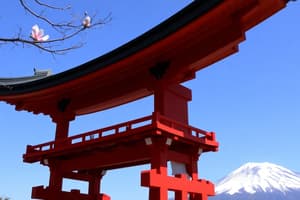Podcast
Questions and Answers
What is the Japanese term for the Japanese Tea Ceremony?
What is the Japanese term for the Japanese Tea Ceremony?
- Wabi-Sabi
- Kintsugi
- Chanoyu (correct)
- Haiku
Which school of Buddhism is deeply associated with the concept of wabi-sabi?
Which school of Buddhism is deeply associated with the concept of wabi-sabi?
- Mahayana Buddhism
- Zen Buddhism (correct)
- Theravada Buddhism
- Tibetan Buddhism
What does the term 'wabi-sabi' refer to in Japanese aesthetics?
What does the term 'wabi-sabi' refer to in Japanese aesthetics?
- Beauty in imperfection (correct)
- Perfect symmetry
- Chaos and disorder
- Extravagance and opulence
Which art form reflects the essence of wabi-sabi through repairing broken pottery with gold or silver lacquer?
Which art form reflects the essence of wabi-sabi through repairing broken pottery with gold or silver lacquer?
What is the syllable pattern of a traditional Haiku poem?
What is the syllable pattern of a traditional Haiku poem?
Which Japanese art form involves repairing broken ceramics with gold, symbolizing imperfection and transformation?
Which Japanese art form involves repairing broken ceramics with gold, symbolizing imperfection and transformation?
Which Japanese philosophy celebrates imperfection and the transient nature of life?
Which Japanese philosophy celebrates imperfection and the transient nature of life?
What is the central focus of a Haiku poem?
What is the central focus of a Haiku poem?
Flashcards are hidden until you start studying
Study Notes
Title: Embarking on the Study of "Ba" and its Connection to Japanese Culture
Japanese Tea Ceremony: A Symphony of Serenity
The Japanese Tea Ceremony, or "Chanoyu" (茶の湯), is an exquisite art form deeply rooted in Japanese culture. This ceremony, which dates back to the 14th century, emphasizes the harmonious union of nature, art, and people. The process of preparing and serving matcha tea is a ritual of grace, mindfulness, and unity that showcases the essence of wabi-sabi.
Zen Buddhism: Embracing the Beauty of Imperfection
Zen Buddhism, also known as Zen, is a school of Buddhism that originated in China and was introduced to Japan in the 12th century. Zen's core philosophy is centered around the practice of mindfulness, meditation, and the pursuit of enlightenment. The concept of wabi-sabi, which values the beauty and tranquility of imperfection, is a fundamental tenet of Zen philosophy.
Wabi-Sabi: Appreciating the Transient Nature of Life
Wabi-sabi, which translates to "beauty in imperfection," is a Japanese aesthetic that is deeply intertwined with Zen Buddhism. Wabi-sabi celebrates the inherent imperfections and asymmetries that exist in nature and life, encouraging us to cherish the fleeting beauty of the present moment. The wabi-sabi aesthetic is evident in Japanese tea ceremonies, poetry, and art, and it can also be seen in the simplicity and elegance of Japanese architecture and gardens.
Haiku Poetry: A Concise Expression of Life's Moments
Haiku, a traditional form of Japanese poetry, consists of three lines with a syllable pattern of 5-7-5. Haiku is intended to capture the essence of a moment, often focusing on nature's seasons, emotions, or fleeting beauty. Haiku poetry is an intimate expression of life's transient and impermanent nature, which ties in perfectly with the wabi-sabi philosophy.
Kintsugi: Healing with Beauty and Art
Kintsugi, also known as kintsukuroi, is the Japanese art of repairing broken ceramics and pottery with gold. This art form beautifully symbolizes the idea of imperfection, repair, and transformation. Kintsugi's aesthetics emphasize the beauty and uniqueness of each piece, rather than hiding its flaws. Kintsugi's methods and values reflect the Japanese commitment to wabi-sabi, the art of embracing imperfection, and the celebration of life's fleeting moments.
In conclusion, the subtopics of Japanese Tea Ceremony, Zen Buddhism, Wabi-Sabi, Haiku Poetry, and Kintsugi offer a rich and diverse exploration of Japanese culture and its intrinsic values. These themes intertwine to paint a picture of a society that cherishes the transient beauty of life, the pursuit of mindfulness, and the art of embracing imperfection. By studying and appreciating these aspects of Japanese culture, we can gain new perspectives on life, art, and the world around us.
Studying That Suits You
Use AI to generate personalized quizzes and flashcards to suit your learning preferences.





